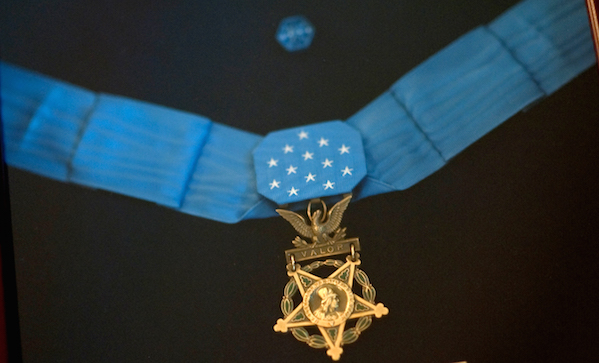It’s tough to believe some of the things that men did to earn the American military’s highest decoration. You’d roll your eyes if you saw some of it in film. In fact, they did make a film of Audie Murphy’s life, and they had to tone the film down.
Those are the kinds of guys profiled in The Medal of Honor: A History of Service Above and Beyond ($28). It’s a history of the award, covering its creation in the Civil War and following its recipients to the present day. We picked eleven of our favourites—but the book is full of amazing, unbelievable, and moving stories.
Archie Van Winkle
Korean War. Lead an infantry charge through enemy fire. Lost his arm to a bullet. Took a grenade directly to the chest. Continued to shout orders to his men while lying on the ground, bleeding. Recovered and served in Viet Nam.
Joel T. Boone
WWI. Treated men under fire and gas attack. Ran out of supplies, replenished supplies under heavy shelling and further gas attack. Ran out of supplies, did the same thing again. Went on to serve in WWII and Korea.
Alvin York
WWI. Took command of unit after commanding officer shot down by machine gun fire. Engaged a machine gun nest single-handed, killed six Germans who fixed bayonets and charged. Killed twenty Germans. Captured thirty-two machine guns and a further 132 Germans.
Audie Murphy
WWII. Joined the Army at sixteen. Ordered his men to retreat to a safe position in the face of an overwhelming German attack while he fired at them with his M1 carbine and called in artillery fire. Jumped into a burning M10 tank destroyer and fired its .50 calibre machine gun at the Germans for a full hour. Killed or wounded fifty Germans. Fired until out of ammo. Re-joined his men, lead them in a charge against the Germans.
Henry ‘Red’ Erwin
WWII. Radio operator of a B-29 Superfortress. A white phosphorous bomb malfunctioned and went off in his face, burning at 1,100 degrees, blinding him and searing off flesh. The plane filled with so much smoke the crew couldn’t see and the plane began to dive. Picked up the bomb between his right arm and ribcage. Ended up burned through to bone. Threw the bomb out the window, saving his crew. Survived.
Richard I. Bong
WWII. Air Force ace fighter pilot—the highest scoring ace. Credited with at least forty Japanese aircraft shot down. Continued flying fighter missions even after pulled from combat and assigned a training role. Died after the war during his career as an experimental test pilot.
Joe M. Jackson
Viet Nam War. Flew 298 combat missions. Instigated impromptu rescue of a 3-man Special Forces team at Kham Duc. Positions on the airstrip were captured by the Vietnamese. Machine gun fire and mortars lashed the same strip. Ammo dumps burned and exploded. Eight aircraft on the field burned, reducing the usable runway to 2,200 feet. Jackson landed under heavy fire, took a dud rocket the nose of his plane, and rescued the men.
Carlos Lozada
Viet Nam War. Part of a forward outpost. Alerted his Company to a Vietnamese attack, killed over twenty Vietnamese with machine gun fire, disrupting the attack. Ordered his comrades to retreat while he stayed. Decision meant certain death—but the Company was saved.
Charles Watters
Viet Nam War. Catholic priest and Army chaplain. Unarmed, aided wounded and dying during battle of Dak To. Rescued paratroopers in the face of withering small arms fire. Left defensive perimeter three times to carry wounded soldiers to safety. Administered last rites to the dying in the face of enemy fire. Died aiding wounded men.
Gary Gordon and Randal Shughart
Somalia. Delta Force sniper team. Volunteered to protect the crew of a crashed Blackhawk helicopter. Inserted 100 meters from site, fought through Mogadishu with only sniper rifles and side arms. Pulled critically injured crew from helicopter, established a perimeter, and fought until they depleted ammunition. Retrieved more weapons and ammo from the downed helicopter, radioed for help, and continued defending their position. Shugart was fatally wounded after depleting ammunition. Gordon returned to the wreckage once more, acquired the last of the ammunition, and gave the dazed pilot a rife and five rounds, telling him “good luck”. Armed with only his pistol, he defended the site until killed. Pilot was captured, but survived.


